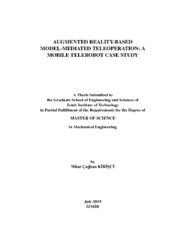Please use this identifier to cite or link to this item:
https://hdl.handle.net/11147/7367| Title: | Augmented Reality-Based Model-Mediated Teleoperation: a Mobile Telerobot Case Study | Other Titles: | Artırılmış Gerçeklik Temelli Model Aracılı Teleoperasyon: Bir Mobil Telerobot Çalışması | Authors: | Kirişci, Nihat Çağhan | Advisors: | Dede, Mehmet İsmet Can | Keywords: | Augmented reality Mobile robots Telepresence Teleoperation Haptics |
Publisher: | Izmir Institute of Technology | Source: | Kirişci, N. Ç. (2019). Augmented reality-based model-mediated teleoperation: A mobile telerobot case study. Unpublished master's thesis, İzmir Institute of Technology, İzmir, Turkey | Abstract: | Teleoperation is defined as operating a robot in a remote environment. Teleoperation
utilizes the strength and dexterity of robots and the interpretation and problem solving
skills of humans. In a teleoperation system, the robot to be controlled is referred as the
slave. The master is a device that the human operator interacts with to send commands to
the slave or receive feedback from the slave environment such as haptic or audio.
However, teleoperation of a robot in an unknown environment solely based on
haptic and visual feedback is a demanding task. The effects of time delay in communication
channels makes completing this task even more challenging. Model-Mediated
Teleoperation (MMT) aims to solve this problem by creating a virtual model of the slave
robot and the environment. This virtual model receives commands from the master and
returns haptic feedback just as the real slave robot is interacting with the environment,
effectively with no delay. However, without actually knowing where the position of the
virtual robot corresponds in the real environment, it is still challenging to carry out the
task. In this project, a novel augmented reality based method is proposed to render the
virtual robot into the real life live video feed. Integration of the non-delayed robot into the
real environment intends to solve this problem by enhancing the perception of the user. Teleoperasyon, uzak ortamdaki bir robotu kontol etmek olarak tanımlanır. Teleoperasyonda, robotların gücününden ve manevra kabiliyetlerinden, insanların ise bir durumu algılama ve çözüm üretme yeteneklerinden faydalanılır. Bir teleoperasyon sisteminde, kontrol edilen robot, bağımlı robot olarak adlandırılır. İnsan kullanıcının etkileşimde bulunarak bağımlı sisteme sinyaller gönderdiği ve bağımlı robotun bulunduğu ortamın bilgisini haptik veya duysal geribildirim olarak aldığı bileşene ise ana/ana sistem denir. Bilinmeyen bir ortamda bulunan robotun, yalnızca haptik veya görsel geribildirim ile kontrol edilmesi zor bir iştir. Ana ile bağımlı sistemler arasındaki haberleşme kanallarından kaynaklanan gecikme ve paket kaybı gibi sorunlar bu işlemi daha da zorlaştırır. Model aracılı teleoperasyon yöntemi, uzak ortamın sanal bir modelini oluşturarak bu sorunun üstesinden gelmeyi amaçlar. Bu sanal model, kullanıcıdan komutlar alarak, hiç gecikme yokmuş gibi gerçek ortamın vereceği tepkiyi taklit eder. Ancak, sanal robotun gerçek ortamda nereye denk geldiğini bilmeden işlemi gerçekleştirmek hala zordur. Bu projede artırılmış gerçeklik bazlı özgün bir teleoperasyon methodu sunulmuştur. Sanal robot, gerçek ortamdan gelen görüntünün üzerine işlenerek kullanıcının algısını, dolayısıyla teleoperasyonun performansını artırmak hedeflenmiştir. |
Description: | Thesis (Master)--Izmir Institute of Technology, Mechanical Engineering, Izmir, 2019 Includes bibliographical references (leaves: 53-55) Text in English; Abstract: Turkish and English |
URI: | https://hdl.handle.net/11147/7367 |
| Appears in Collections: | Master Degree / Yüksek Lisans Tezleri Sürdürülebilir Yeşil Kampüs Koleksiyonu / Sustainable Green Campus Collection |
Files in This Item:
| File | Description | Size | Format | |
|---|---|---|---|---|
| T002008.pdf | MasterThesis | 14.06 MB | Adobe PDF |  View/Open |
CORE Recommender
Page view(s)
408
checked on May 5, 2025
Download(s)
286
checked on May 5, 2025
Google ScholarTM
Check
Items in GCRIS Repository are protected by copyright, with all rights reserved, unless otherwise indicated.